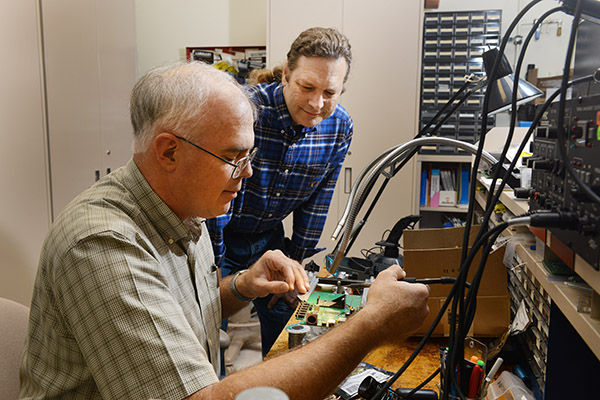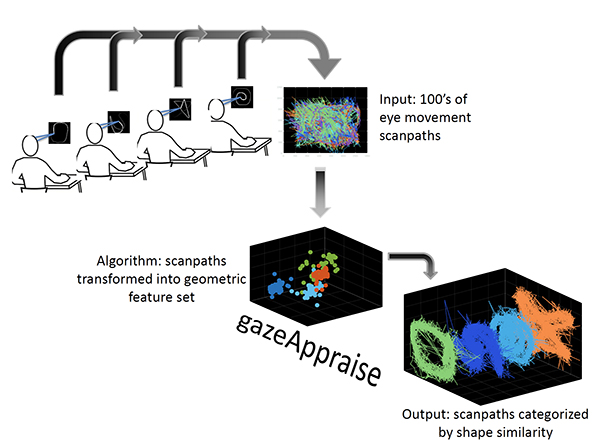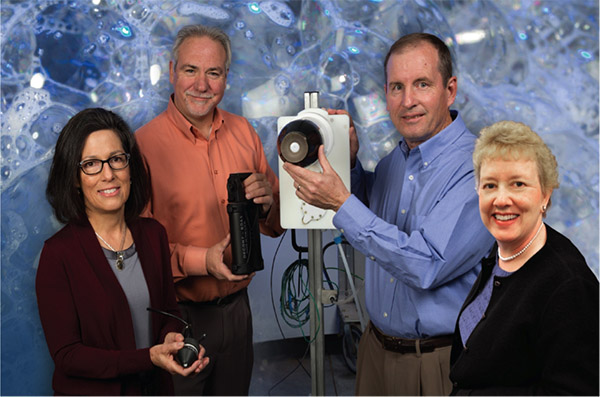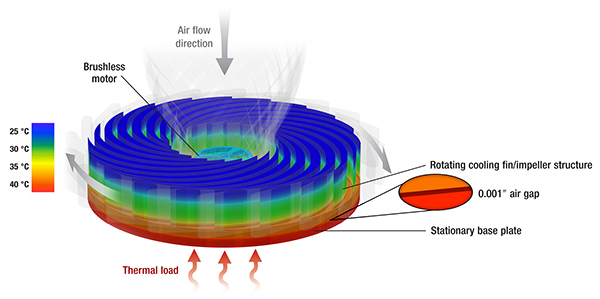Sandia has bright minds tackling big challenges in science and engineering. That work creates a treasure trove of technology vital to national security but also to everyday life. From solid state lighting to medical diagnostics, the Labs consistently hands over skills, knowledge, and technologies to the private sector, and ultimately the public.
See also: A record of tech transfer success

Dan Daily grew up watching his mom run a daycare center for severely disabled children in Taos, New Mexico. “The kids impressed me,” he says. “They were regular people but with disabled bodies. It stuck with me.”
Daily became a musician and, inspired by those kids, dreamt of developing an electronic instrument anyone could play. He wanted to bring music to people who didn’t have the mental or physical ability to play a traditional instrument. He envisioned a microcontroller-based system that would send signals through a USB connection to another electronic device, such as a sound module or computer, which would produce the tones of trumpets, horns, strings, drums, and other musical instruments, all controlled with a simple joystick or mouse.
The technology was more than Daily could handle but as a tiny startup venture, he couldn’t afford R&D. He turned to New Mexico Small Business Assistance, a state-funded program that lets entrepreneurs get technical help from premier scientists at Sandia and Los Alamos national laboratories. Daily was paired with Sandia microsystems engineer Kent Pfeiffer (8634), who had a background in music and helped him bring his dream to life.
Daily’s MidiWing can be manufactured for schools, hospitals, therapy and rehab centers, and other places where people want to make music. “My motivation was to bring music-making to more people,” says Daily, who founded a company, Musicode Innovations. “Kent was pivotal. It was an incredible collaboration because he is a musician. The key to the whole project was that he understood what I was trying to do from a musician’s standpoint. He was perfect. He has a music background and designs microcontroller products. I can’t imagine how it could have gone better.”
A mandate to share
Hardly a day goes by at Sandia that technology isn’t transferred to the private sector. “Tech transfer is a government-mandated mission for institutions receiving federal funding for research,” says Grant Heffelfinger, director of Advanced Science and Technology Program Management Center 1100. “That mission is deeply rooted at Sandia.”
The Labs has a wide variety of programs that pass along skills, knowledge, and technologies to those who can further develop them into new products, processes, and services for the public good.
Programs such as New Mexico Small Business Assistance, Cooperative Research and Development Agreements, and intellectual property licensing ensure that the public can access taxpayer-funded research and world-class scientists and facilities. The Labs works in partnership with private businesses — large and small — and with federal, state, and local agencies, academic institutions, and the local community.

“Tech transfer is a powerful economic development tool,” Grant says. “Sandia’s programs have created thousands of jobs, launched dozens of companies, and pumped billions of dollars into the local, regional, and national economies.”
The numbers are staggering. Sandia has signed more than 5,000 partnership agreements in the past five years to develop its own technology and to help others. The Labs worked with 830 unique industrial partners and hundreds more small and startup businesses.
"Sandia’s programs have created thousands of jobs, launched dozens of companies, and pumped billions of dollars into the economy"
Products that have become a part of peoples’ daily lives, such as solid state lighting and high-efficiency engines, came from Sandia R&D that was commercialized.
“Sandia’s technologies are vital to national security, and moving them swiftly to the marketplace advances US economic competitiveness,” Grant says. “Sandia’s strategic partnerships with industry and universities strengthen and accelerate technology transfer.”
Here’s a look at some of Sandia’s key technology transfer programs, and their impact on the public:

New Mexico Small Business Assistance
NMSBA lets small companies with technical challenges work with scientists and engineers at Sandia and Los Alamos free of charge. It was established in 2000 by the state legislature, which funds it through a tax credit. From 2000 to 2016, the program provided 2,648 companies in all 33 of the state’s counties $53.3 million worth of research hours and materials.
It has helped create and retain 5,734 New Mexico jobs at an average salary of $39,000, increase small companies’ revenues by $272 million and decrease their operating costs by $142 million. Those companies invested $109 million in other New Mexico goods and services, and received $111 million in new funding and financing.
“NMSBA is a phenomenal way to help small companies that don’t have the resources to do advanced research and development,” says Jackie Kerby Moore, manager of Technology and Economic Development Dept. 1183. “National laboratory expertise helps these business people realize their dreams and stimulates the state’s economy.”
Entrepreneurial Separation to Transfer Technology
For more than 20 years, Sandia researchers have been able to leave to start or join small companies, knowing they can return. Their work has made a difference by creating hundreds of jobs, bringing national lab expertise into the private sector and boosting economic development.
“The Entrepreneurial Separation to Transfer Technology program is an innovative tech transfer tool that has endured,” says Jackie. “We have many success stories and have measured the economic impact, which shows positive benefits to the local community. And entrepreneurs who return to Sandia bring new experiences that benefit the Labs.”
One of Sandia’s hottest technologies, the medical diagnostic lab-on-a-disk SpinDx, is being commercialized through the program. Greg Sommer, a former Sandia researcher who helped develop SpinDx, co-founded and is chief executive officer of Sandstone Diagnostics in Livermore, California, which is bringing the technology to market. “The high-tech environment at Sandia is ripe for innovation and game-changing technologies,” Sommer says. “The entrepreneurial separation program allowed us to launch Sandstone and develop cutting-edge medical products based on technology we originally developed for Sandia’s biodefense missions.”
Some 156 Sandia researchers have left, 70 to start a business and 86 to expand one. About 30 of the companies they joined or started licensed a Sandia technology.
EEx is designed to invigorate an entrepreneurial culture at the labs and inspire researchers whether they leave or remain at Sandia. The program has been in place about two years and includes entrepreneur office hours, when researchers can meet and talk to members of the business community; workshops; roundtables; boot camps; and social gatherings.
“More than 1,800 community leaders, entrepreneurs, and Sandians have attended the EEx events,” Jackie says. “It links the community to Sandia with opportunities for entrepreneurs.”

Sandia Science & Technology Park
The park is a 300-plus acre master-planned technology community affiliated with Sandia and adjacent to Kirtland Air Force Base, giving companies easy access to top-notch facilities. The park is home to 42 companies and organizations with 2,008 employees. The average annual salary is $83,000.
Since the park opened in 1998, public investment has totaled $89 million and private $286.5 million. Some 6,593 direct and indirect jobs have been created. Wages and salaries from park activities total $4.4 billion.
“The park plays a critical role in our economy,” says Jackie, the park’s executive director, “It creates high-quality, high-wage, long-term jobs rooted in technology, innovation, and entrepreneurship.”
Sandia is one of five leads in a DOE pilot that gives small, clean-energy companies access to national laboratory expertise and resources. Eleven DOE labs are working with the private sector with a combined budget of $22 million. Sandia’s 17 vouchers from the program’s first three rounds total $3.7 million and include projects in advanced manufacturing, bioenergy, fuel cells, geothermal energy, solar energy, and wind and water power.
Andy McIlroy, director of Energy and Homeland Security Program Management Center 8100, says companies can propose collaborative research with a particular scientist, request technical assistance from an engineer, or gain access to such Sandia facilities as the Microsystems Science and Technology Center, the National Solar Thermal Test Facility, or the Battery Abuse Testing Laboratory.
“The program gives companies an array of options to meet their technical challenges,” Andy says. “Sandia and the other labs have decades of R&D experience in clean energy technologies and an incredible amount of knowledge to share with these small businesses.”
Cooperative Research & Development Agreements
A CRADA is an agreement between a government agency and a private company or university — or at least one non-federal entity — to work together on research and development. Sandia signed 133 during the past four fiscal years, from October 2012 to September 2016; 110 were new and 67 were amendments adding tasks or funding to existing agreements. From 2006 to 2016, 292 new agreements were signed and 312 were amended.
Sandia has active CRADAs with 65 partners ranging from small businesses to nonprofits to industry giants.
“This is a great mechanism for getting national laboratory technology into the private sector,” says Sandia CRADA specialist Jason Martinez (10575). “We develop cutting-edge technology and capabilities with underlying science that is phenomenal. The CRADA is a vehicle to take that work and benefit the US economy.”
Strategic Partnership Projects, Non-Federal Entity Agreements
These are bilateral contracts that lets Sandia do work for a non-federal entity sponsor, making the Labs’ resources available to private industry and individuals, state and local governments, colleges and universities, nonprofit organizations, international organizations, foreign governments, and foreign companies. From 2006-2016, Sandia signed 807 new agreements and 767 amendments.
Intellectual property licensing
Partners can license Sandia’s IP, including patents, copyrights, trademarks, and mask works, for commercialization or private use. From 2006-2016, patent activity included 3,319 invention disclosures, 2,076 patent applications, and 1,013 patents issued. There were 1,394 copyright submissions and 3,668 commercial and non-commercial technology licenses granted.
Sandia partners with key universities to do cutting-edge science, hire the best scientists and engineers, and develop strategic collaborations in focused research areas. From 2006-2016, investments in research totaled $310.9 million at all universities and $60.8 million at New Mexico universities.
Grants says US taxpayers have invested billions in research and development at federal laboratories, and the return is scientific and technological breakthroughs that lead to new companies, jobs, and growth in the economy. “Our technology transfer programs ensure that the nation receives that maximum return from the R&D investments made at Sandia,” he says. “These are technologies that change lives and make the world a better place.”
A record of tech transfer success
Sandia’s tech transfer efforts have been recognized dozens of times by the Federal Laboratory Consortium, a nationwide network of more than 300 federal laboratories, agencies and research centers that fosters commercialization best practice strategies and opportunities for accelerating federal technologies out of the labs and into the marketplace. The Sandia awards have been in categories ranging from Excellence in Technology Transfer to State and Local Economic Development to Regional Partnerships. Among the technologies singled out were:
- BaDx, a credit-card-size device that can detect bacteria that cause anthrax;
- Sandia Cooler, which reduces energy to cool computer processor chips;
- GazeAppraise, an eye movement analysis software;
- X-Ray Toolkit, a software program that helps emergency responders perform effectively in the high-stress, time-critical act of disabling improvised explosive devices;
- Decontamination Technology for Chemical and Biological Agents, which neutralizes 99.99999 percent of bacteria, viruses and fungi;
- Twistact, designed to take wind energy to the next level;
- H2FIRST, an effort to increase the number of fueling stations for hydrogen cell electric vehicles.